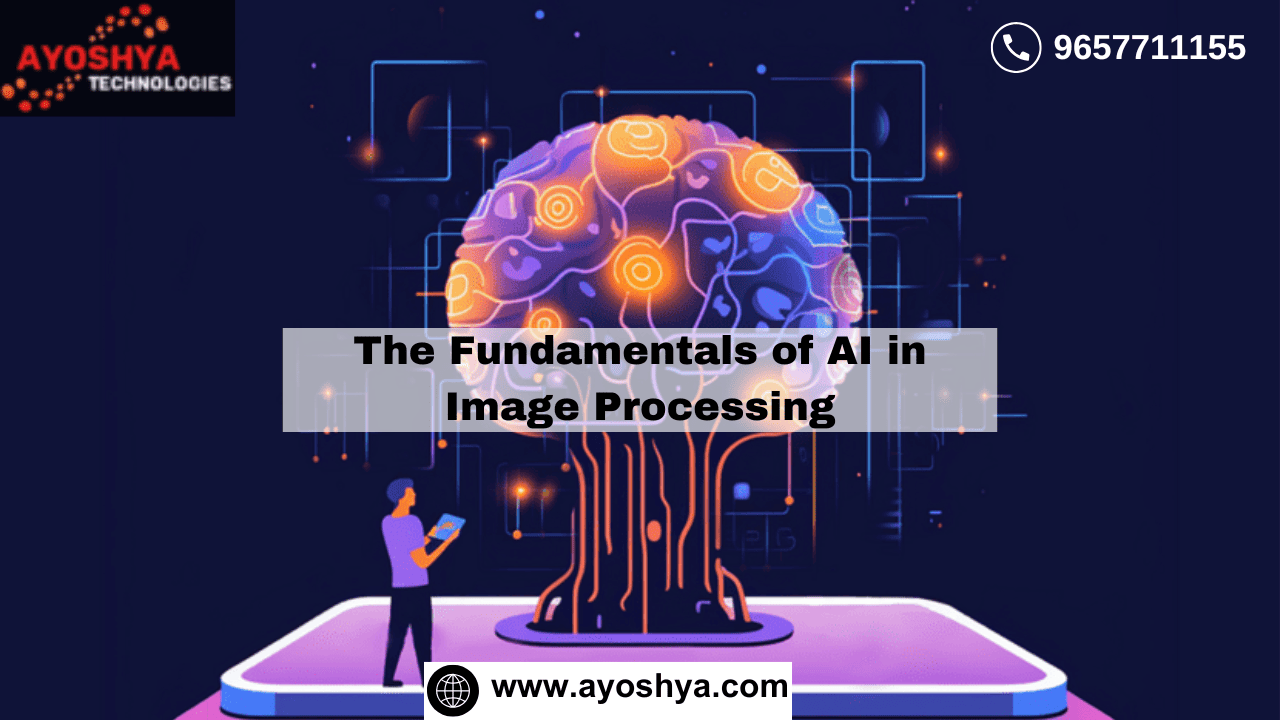The Fundamentals of AI in Image Processing
Fundamentals of AI in Image Processing
- AI image processing uses artificial intelligence to analyze and enhance images.
- It involves tasks like pattern recognition, object detection, and image classification.
- Core technologies include deep learning, neural networks, and machine learning algorithms.
- Revolutionizes healthcare, security, and entertainment by automating complex tasks and improving accuracy.
The Basics of AI Image Processing

AI image processing is a pivotal technological innovation, transforming how digital images are analyzed and enhanced.
This section delves into the basics of AI in image processing, tracing its evolution and highlighting its transformative impact on traditional methodologies.
Definition and Scope
AI image processing uses artificial intelligence technologies to interpret and manipulate digital images.
This involves recognizing patterns, detecting objects, and predicting future events within images. AI’s scope in image processing extends across various fields, including healthcare, security, and entertainment, proving its versatility and utility.
The Evolution of Image Processing Technology
- Early Stages: Initially, image processing relied heavily on manual intervention and basic computer vision techniques.
- Advancement in Technologies: The introduction of machine learning and AI algorithms revolutionized image processing, enabling automated and sophisticated analysis.
- Present and Future: Today, AI image processing is at the forefront of technological advancements, with ongoing research pushing the boundaries of what’s possible.
How AI Transforms Traditional Image Processing
AI has dramatically altered the landscape of image processing by:
- Automating Complex Tasks: AI algorithms can perform tasks such as object detection and image classification much more efficiently than traditional methods.
- Improving Accuracy: The use of deep learning and neural networks has significantly improved the accuracy of image analysis.
- Expanding Capabilities: AI has introduced new capabilities, such as facial recognition and augmented reality, which were difficult to achieve with traditional image processing techniques.
Improving Image Quality with AI

AI plays a significant role in elevating the quality of digital images and addressing common challenges such as noise, resolution, and color discrepancies.
By applying advanced algorithms, AI not only refines the visual appearance of images but also ensures that the details are preserved and accurately represented.
Techniques for Improving Image Quality
- Noise Reduction: AI algorithms can effectively identify and remove digital noise from images, leading to clearer and more precise visuals. This is particularly useful in low-light photography and medical imaging, where clarity is crucial.
- Super-resolution: Through AI, images can be transformed to higher resolutions without losing detail. Super-resolution techniques use AI to predict and fill in missing information in lower-resolution images, making them sharper and more defined.
- Color Correction: AI assists in adjusting an image’s colors to make them more accurate or aesthetically pleasing. This involves balancing color levels, enhancing saturation, and automatically correcting tones based on the image’s context.
Real-World Examples of Enhanced Imaging

The application of AI in image quality improvement is evident across various fields:
- In smartphone photography, AI-enhanced cameras automatically adjust settings for optimal noise reduction and color accuracy.
- In satellite imagery, super-resolution techniques are used to improve the detail of images used for geographic analysis.
- AI recovers and enhances historical footage in film restoration, correcting color fading and removing artifacts.
Analyzing Images with AI
Analyzing images through AI extends beyond mere enhancement, understanding, and interpreting content within images.
AI-driven image analysis can dissect complex visuals, identify components, and understand patterns, facilitating various applications.
Image Segmentation and Its Applications
- Image Segmentation: This process divides an image into parts or segments to simplify its analysis or modify its representation. AI-driven segmentation is crucial in medical imaging for isolating specific anatomical structures and in autonomous driving for distinguishing between different elements in the visual field.
Object Detection and Tracking
- Object Detection and Tracking: AI identifies and locates objects within images, tracking their movement across frames. This capability is instrumental in surveillance to monitor activities, in retail to analyze customer behavior, and in wildlife studies to observe species.
Pattern Recognition and Classification
- Pattern Recognition and Classification: AI excels at identifying patterns within images and classifying them. This function supports facial recognition systems, aids in diagnosing diseases through medical imaging, and enhances security measures by detecting prohibited items in scanned imagery.
AI’s role in analyzing images encompasses various techniques and applications, demonstrating its transformative impact across industries.
From enhancing the clarity and detail of visuals to understanding and interpreting complex image content, AI-driven image processing continues to redefine the possibilities within digital imaging.
Core Technologies Behind AI Image Processing

The advancement of AI in image processing is largely attributed to the development of specific core technologies that enable the interpretation and manipulation of complex image data.
These technologies have revolutionized the field, providing the foundation for numerous applications across various industries.
Deep Learning and Neural Networks
Deep learning, a subset of machine learning, utilizes neural networks with multiple layers to analyze vast amounts of data.
These networks are capable of learning unsupervised from unstructured or unlabeled data. In image processing, deep learning enables the automatic extraction of features and patterns from images, significantly improving the accuracy of subsequent analyses.
Convolutional Neural Networks (CNNs)
CNNs represent a pivotal innovation in neural networks. They are specifically tailored to process pixel data in images.
Their unique architecture mimics the human visual cortex and effectively allows them to recognize patterns, shapes, and objects within images.
CNNs play a crucial role in image analysis, facilitating tasks such as image classification, object detection, and scene understanding with remarkable efficiency and accuracy.
Machine Learning Algorithms for Image Classification and Recognition
Machine learning algorithms are at the heart of AI’s ability to classify and recognize objects within images.
These algorithms learn from a set of training data to make predictions or decisions rather than following strictly static program instructions. In image processing, such algorithms can identify specific features or objects, enabling various applications, from automated photo tagging to sophisticated surveillance systems.
Applications of AI in Image Processing

AI technologies have found widespread application in image processing, significantly enhancing capabilities in various fields.
These applications showcase AI’s versatility and highlight its potential to improve efficiency, accuracy, and outcomes in everyday and critical tasks.
Medical Imaging and Diagnostics
In healthcare, AI-driven image processing is revolutionizing diagnostics by providing more accurate, faster analyses of medical images such as X-rays, MRIs, and CT scans.
These technologies can detect anomalies that the human eye may overlook, aiding in the early diagnosis of diseases such as cancer and cardiovascular diseases.
Surveillance and Security Systems
AI enhances surveillance and security systems by automatically detecting and recognizing suspicious activities or individuals. This capability allows for real-time alerts and has improved worldwide public safety and security operations.
Facial Recognition Technology
Facial recognition has become a staple in security and consumer electronics thanks to AI image processing.
This technology can accurately identify individuals in a crowd or through devices, supporting applications in law enforcement, secure access systems, and personalized user experiences.
Augmented Reality (AR) and Virtual Reality (VR)
AI is also pivotal in developing AR and VR technologies, where it processes and integrates digital images with the real world or creates entirely virtual environments.
These applications are transforming entertainment, education, and design, offering immersive experiences that were previously impossible.
Top 10 Real-Life Use Cases for AI Image Processing

AI image-processing technology has permeated various industries, offering innovative solutions and substantial benefits.
Below are ten significant real-life applications:
- Healthcare – Diagnostics with Deep Learning: Tools like Enlitic’s deep learning application analyze X-rays, MRIs, and CT scans, identifying patterns indicative of diseases. This technology improves diagnostic accuracy and speeds up patient treatment plans.
- Retail – Customer Experience with Computer Vision: Amazon Go uses computer vision to offer a checkout-free shopping experience. Cameras track what shoppers pick up, charging their accounts as they leave, streamlining the shopping process and enhancing customer satisfaction.
- Automotive – Autonomous Driving with CNNs: Tesla Autopilot utilizes convolutional neural networks (CNNs) for image recognition to enable vehicles to navigate safely. This technology improves road safety by reducing human error.
- Security – Surveillance Systems with Object Detection: Security firms use AI tools like IBM Watson to analyze surveillance footage in real time, detecting unauthorized access or suspicious behaviors, thereby enhancing security measures.
- Agriculture—Crop Analysis with Drones and AI: AeroFarms employs drones equipped with AI to capture and analyze images of crops. This data helps monitor plant health, optimize agricultural practices, and increase yield.
- Finance – Fraud Detection with Machine Learning: PayPal uses machine learning algorithms to analyze transaction images and detect fraud patterns. This significantly reduces the incidence of fraudulent transactions, protecting the company and its users.
- Manufacturing – Quality Control with AI Vision Systems: Companies like BMW employ AI vision systems to inspect parts and products. These systems detect defects more accurately than human inspectors, ensuring product quality and reducing waste.
- Entertainment – Movie Effects with Generative Adversarial Networks (GANs): Studios like Industrial Light & Magic use GANs to create realistic movie visual effects. This technology allows for creating scenes and characters that seamlessly blend with live-action footage.
- Environmental Conservation – Wildlife Monitoring with AI: The Wildlife Conservation Society uses AI image processing to analyze camera trap images, identifying and counting animals. This aids in monitoring species populations and conservation efforts.
- Education – Interactive Learning with AR: Educational platforms integrate Google’s ARCore to create interactive learning experiences. By processing images of the real world, ARCore enables students to visualize complex academic concepts more engagingly and understandably.
These use cases demonstrate the versatility and impact of AI image processing across different sectors, offering efficiency, accuracy, and innovation improvements.
Challenges and Ethical Considerations in AI Image Processing

As AI continues to evolve and become more integral to image processing, it brings challenges and ethical considerations that must be addressed to ensure its responsible use.
Data Privacy and Security Concerns
With the increasing use of AI in image processing, concerns around data privacy and security have heightened.
Images often contain sensitive information, and using AI to process these images raises questions about how data is stored, who has access to it, and how it is protected against unauthorized access or breaches.
Bias and Fairness in AI Algorithms
Another significant challenge is the potential for bias within AI algorithms. If the data used to train these algorithms is not diverse, there’s a risk that the AI systems will develop biases, leading to unfair or discriminatory outcomes.
Ensuring fairness in AI algorithms requires continuous effort in monitoring, testing, and updating the systems to address and mitigate any biases.
The Future of Ethical AI in Image Processing
Looking ahead, the future of ethical AI in image processing depends on developing robust guidelines and standards that govern its use.
This includes establishing clear ethical principles for AI development and use, promoting transparency in AI algorithms, and ensuring that AI systems are designed with the public interest in mind.
The Future of AI in Image Processing

AI in image processing is on the brink of significant breakthroughs and transformations. As we look towards the future, several trends and areas of research stand out as particularly promising.
Emerging Trends and Ongoing Research
Current research in AI image processing is exploring more sophisticated models and algorithms that can process images with even greater accuracy and speed.
There’s also a growing focus on developing AI systems that can understand the context within images, enabling a deeper analysis beyond simple object recognition.
The Potential Impact of Quantum Computing on AI Image Processing
Quantum computing has the potential to revolutionize AI image processing by offering processing capabilities far beyond those of classical computing.
This could lead to breakthroughs in how quickly and efficiently AI systems can learn from and analyze image data, opening up new possibilities for real-time image processing applications.
Predictions for the Next Decade
Over the next decade, AI image processing will become more integrated into daily life, with applications ranging from advanced medical diagnostics to sophisticated surveillance systems.
We’re also likely to see AI becoming more adept at interpreting images in a way that mirrors human understanding, further blurring the lines between AI-generated insights and human perception.
FAQs
What is AI image processing?
AI image processing involves using artificial intelligence to analyze images and perform tasks such as pattern recognition, object detection, and classification.
How does AI image processing differ from traditional methods?
AI methods automate and carry out complex analyses more accurately than traditional image processing, thanks to machine learning and neural networks.
What are the core technologies behind AI image processing?
Deep learning, neural networks, and machine learning algorithms are fundamental to AI’s capabilities in image analysis.
In which fields is AI image processing applied?
It’s widely used in healthcare for diagnostics, security systems for surveillance, and entertainment for enhanced digital experiences.
How does AI improve object detection in images?
AI algorithms can learn from vast datasets to recognize and accurately locate objects in images.
Can AI image processing be used for facial recognition?
Yes, AI is instrumental in facial recognition technologies, offering applications in security and personalized user experiences.
What is pattern recognition in AI image processing?
AI can identify regularities and anomalies within images, which is crucial for various analytical applications.
How do neural networks contribute to AI image processing?
Neural networks mimic human brain functionality to learn from image data, enabling the accurate interpretation of complex image content.
What is the significance of deep learning in AI image processing?
Deep learning allows for analyzing deeper layers of image data, uncovering intricate patterns that aren’t visible to the human eye or traditional methods.
How is AI used in medical image diagnostics?
AI algorithms analyze medical imagery with high accuracy to diagnose diseases, plan treatments, and monitor patient progress.
What advancements has AI brought to security and surveillance?
AI enhances security systems with real-time monitoring, face recognition, and anomaly detection, contributing to safer public and private spaces.
How does AI contribute to the entertainment industry?
In entertainment, AI personalizes content, creates realistic visual effects, and automates the editing process for movies and video games.
What challenges are faced in AI image processing?
Data privacy, algorithm bias, and the need for extensive training data are significant challenges in the field.
How do machine learning algorithms classify images?
They analyze features within images, learning from training data to categorize new images accurately.
What future developments are expected in AI image processing?
Continued research aims at more sophisticated algorithms for real-time processing, improved accuracy, and expanding industry applications.
You may be interested in:
SAP Consulting | Ayoshya Technologies
SAP ABAP on HANA Interview Questions: Mastering the Essentials



